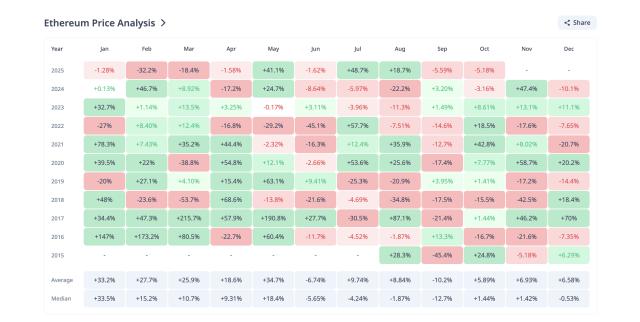Author: SpecialistXBT
A team with no official website, no community, and no team affiliation devoured nearly half of the trading volume on Jupiter within 90 days.
To gain a deeper understanding of this mysterious project, we must first delve into the on-chain transaction revolution that is quietly taking place on Solana.
HumidiFi processes 42% of Jupiter's total transaction volume.
Source: Dune, @ilemi
How to restructure on-chain transactions using a self-operated AMM
In the context of AMM, toxic order flow refers to the ability of high-frequency arbitrageurs to preemptively capture price discrepancies using low-latency connections and advanced algorithms, and quickly smooth out the price difference between the on-chain and price discovery venues (usually centralized exchanges such as Binance). The profits taken away by these toxic order flows are ultimately borne by traders, liquidity providers, and on-chain market makers.
In traditional financial markets that use centralized order books (CLOBs) for order matching, professional market makers can cope with toxic order flows through various means, such as adjusting spreads and pausing quotes. They can identify traders with informational advantages by analyzing order flow patterns and adjust their quotes accordingly, thereby reducing losses caused by adverse selection. Therefore, market makers operating on Solana naturally chose DEXs like Phoenix that use CLOBs. However, during the Solana "meme frenzy" of 2024-early 2025, the Solana network was overwhelmed by unprecedented demand. Market makers' orders frequently failed to be submitted to the blockchain, and updating quotes required a large amount of expensive computing units, causing a sharp increase in market makers' costs.
A series of thorny practical problems are forcing a group of the most experienced AMM market makers to fundamentally rethink how on-chain markets operate, and a revolutionary new market structure is beginning to emerge.
This new paradigm is called "Prop AMM" and its goal is to provide more efficient liquidity with lower spreads on-chain while minimizing the risk of being exploited by high-frequency arbitrageurs.
SolFi, ZeroFi, and Obric were the original "big three" of proprietary AMMs. They did not expose their contract interfaces but instead provided them directly to major trading routes like Jupiter, requiring Jupiter to route orders to their AMMs. This design made it extremely difficult for external professional arbitrageurs like Wintertermute to interact natively with the contracts, as they could not understand or predict the trading logic. This prevented market makers' quotes from being replaced and the "adverse selection" problem for those with an information advantage.
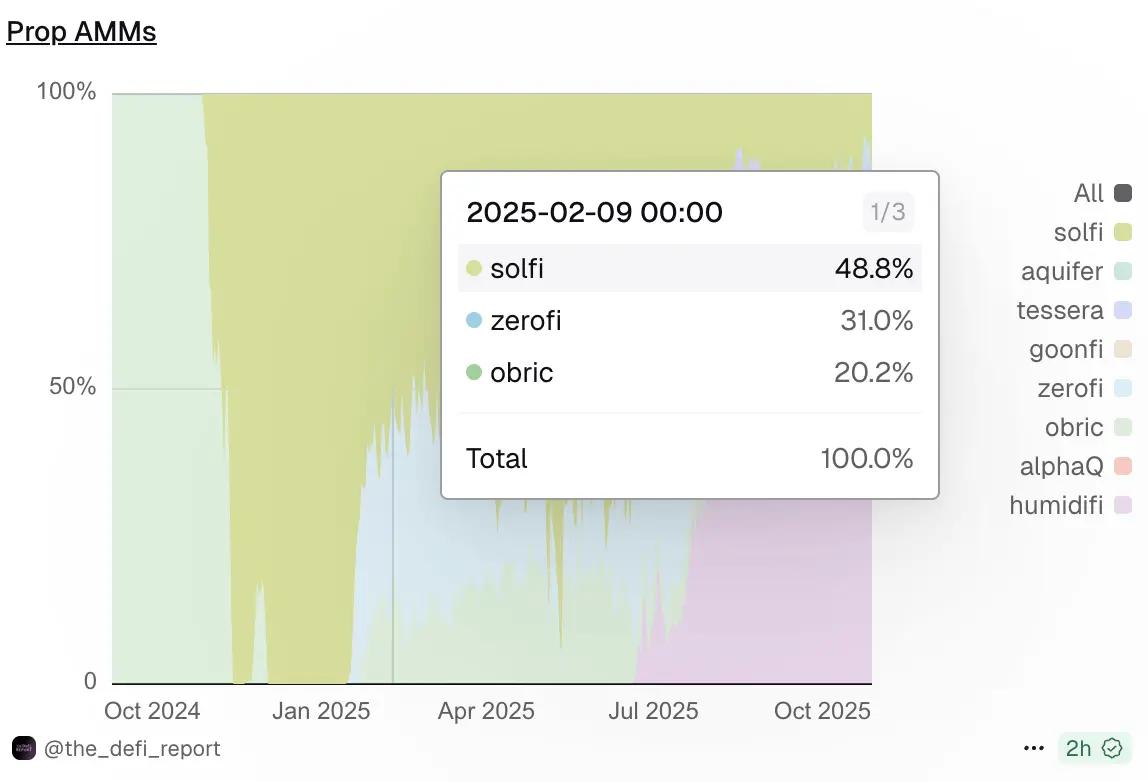
In February 2025, SolFi, ZeroFi, and Obric were the three main self-operated AMMs.
Source: Dune @the_defi_report
HumidiFi's Blitzkrieg
Competition among self-operated AMMs will become fierce by July 2025, while a project called HumidiFi is rewriting the entire market landscape at an astonishing pace.
HumidiFi officially launched in mid-June 2025, and within just two months, it had captured 47.1% of all proprietary AMM trading volume, becoming the undisputed market leader. In contrast, the market share of the former champion, SolFi, plummeted from 61.8% two months prior to 9.2%.
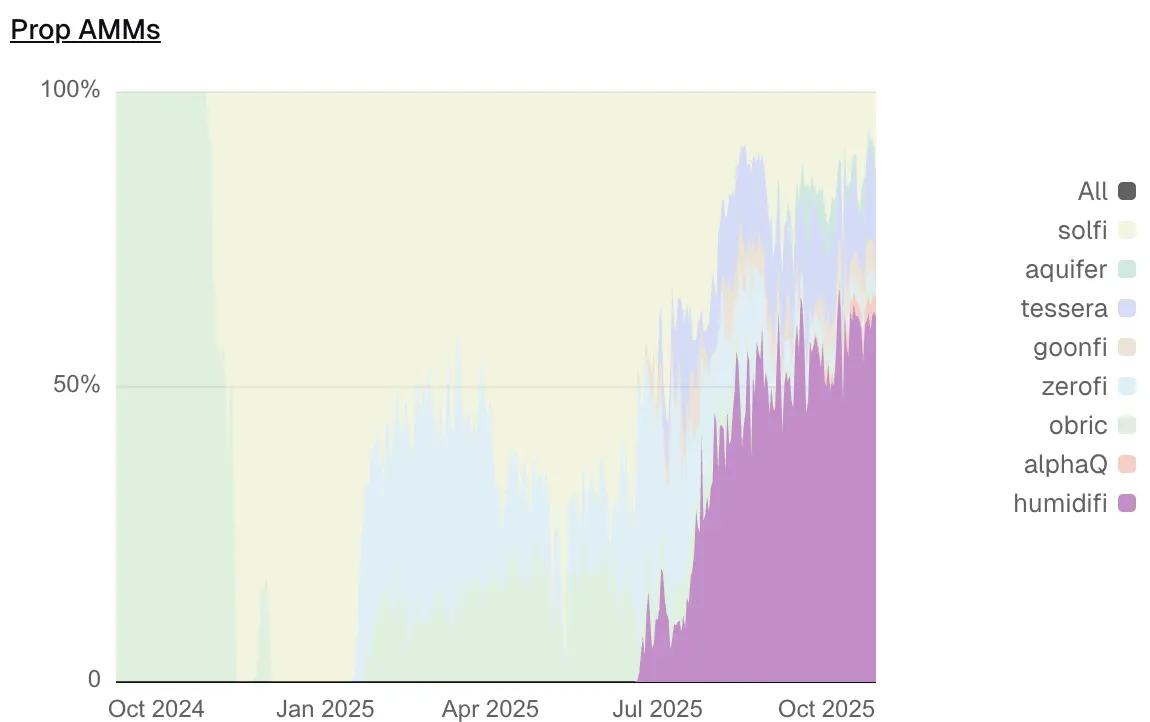
Source: Dune @the_defi_report
HumidiFi's dominance is particularly evident in the SOL/USDC trading pair. On October 28th, HumidiFi processed $1.08 billion in SOL/USDC transactions, accounting for 64.3% of the total volume for that pair that day.
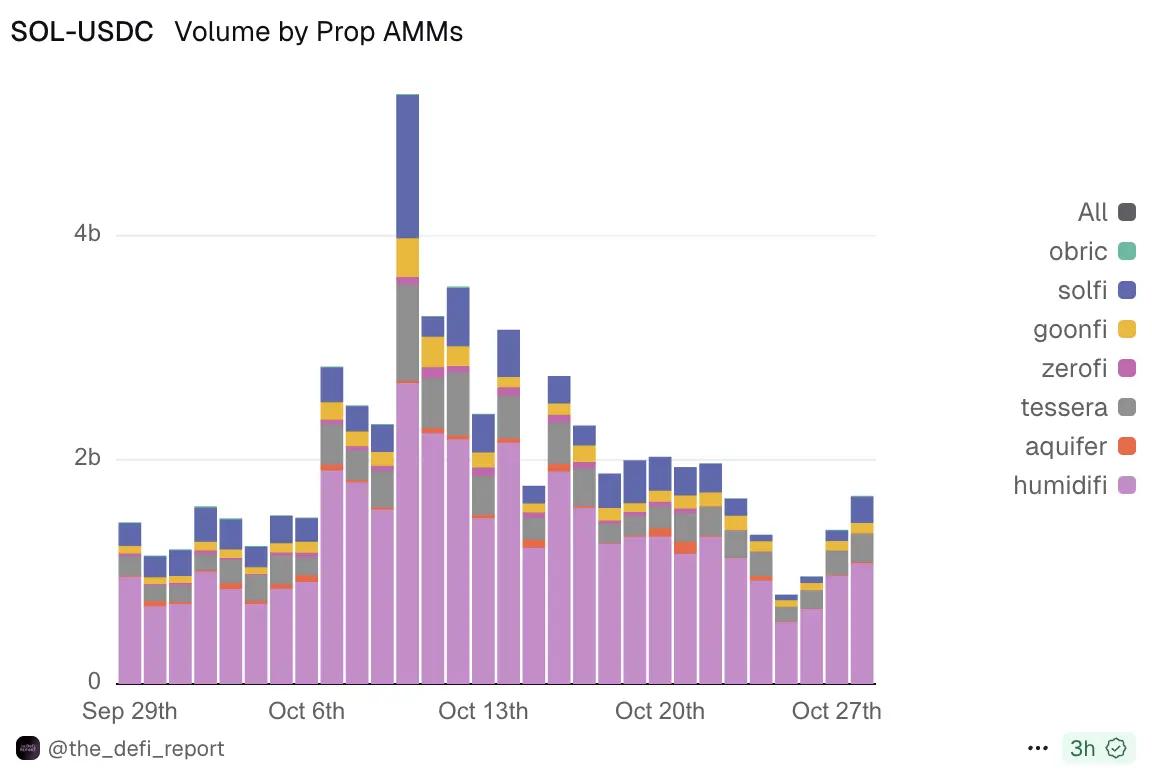
Source: Dune @the_defi_report
HumidiFi also boasts extremely high penetration in Jupiter routing. As the aggregator holding 86.4% market share on Solana, Jupiter's routing options largely determine the actual trading experience. Data from October 20th shows that HumidiFi's market share on Jupiter reached 46.8%, more than four times that of the second-place TesseraV (10.7%).
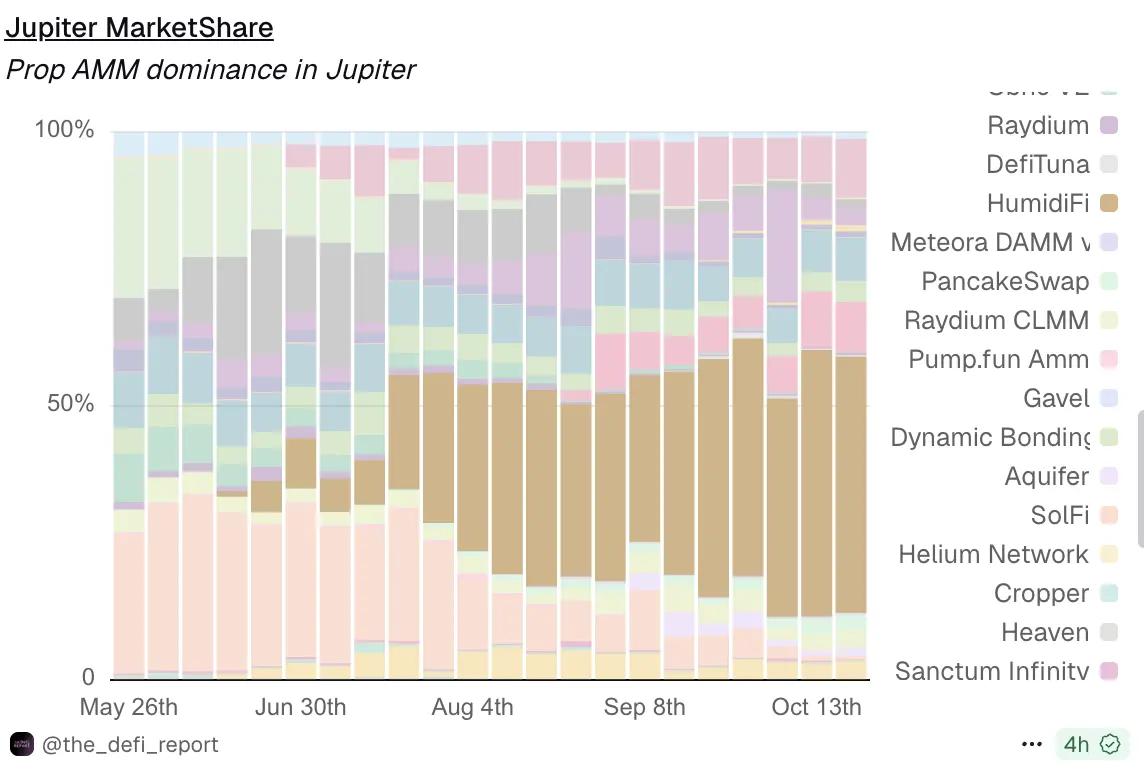
Source: Dune @the_defi_report
Expanding our view to the entire proprietary AMM ecosystem, HumidiFi's dominance remains solid. On October 28th, the total trading volume of all proprietary AMMs reached $2.18 billion, with HumidiFi accounting for $1.35 billion, a staggering 61.9%. This figure not only far exceeds SolFi's $309 million in second place, but also surpasses the combined trading volume of all competitors ranked 2nd to 8th.

Source: Dune @the_defi_report
HumidiFi's victory was achieved almost entirely in stealth. It had no official website, no Twitter account in its early days, and no information about its team members was ever made public.
HumidiFi needs no marketing, no airdrops, and no storytelling. It simply needs to offer better spreads and execution prices than its competitors on every trade. As Jupiter's routing algorithm repeatedly selects HumidiFi, the market has already cast its vote.
The ultimate race between speed and cost
The key to HumidiFi's success lies in its ability to minimize the computational cost of oracle updates and cleverly transform this technological advantage into absolute market dominance through the Jito auction mechanism.
First, HumidiFi consumes very few computing resources. According to data provided by @bqbrady, each oracle update of HumidiFi consumes only 799 CUs (computing units). In comparison, its main competitor, SolFi, requires 4339 CUs. TesseraV, operated by top market maker Wintermute, also requires 1595 CUs, twice that of HumidiFi.

Source: X, @bqbrady
HumidiFi also fully leveraged its low CU consumption to achieve absolute transaction priority in Solana's MEV infrastructure Jito auctions. In Jito auctions, transaction priority is not determined by absolute tips, but by tips per CU. HumidiFi pays approximately 4,998 lamports in tips per oracle update. Due to its extremely low CU consumption (799 CUs), its tip per CU ratio reaches an impressive 6.25 lamports/CU.

According to data provided by Brennan Watt, an engineer at Anza, the core developer of Solana, HumidiFi used 6 times less CU than SolFi, the former leader in Prop AMMs, and gave more than 8 times more tips.
Another key advantage of HumidiFi is the frequency of its oracle updates. HumidiFi updates its oracles 17 times per second, far exceeding its main competitors (SolFi's 13 times, TesseraV's 11 times, and ZeroFi's 10 times).
In the midst of the volatile cryptocurrency market, this near-real-time price tracking capability allows it to stay close to fair value, preventing arbitrageurs from taking advantage of the situation, while also providing tighter liquidity without the need for self-protection by widening price spreads.
In addition, HumidiFi excels in cost control. HumidiFi's daily operating costs are only $2,247. In contrast, SolFi, despite having five times the assets under management (AUM) of HumidiFi ($8 billion vs. $1.6 billion), has daily costs that are only 20% lower ($1,785).
WET tokens are listed on Jupiter DTF.
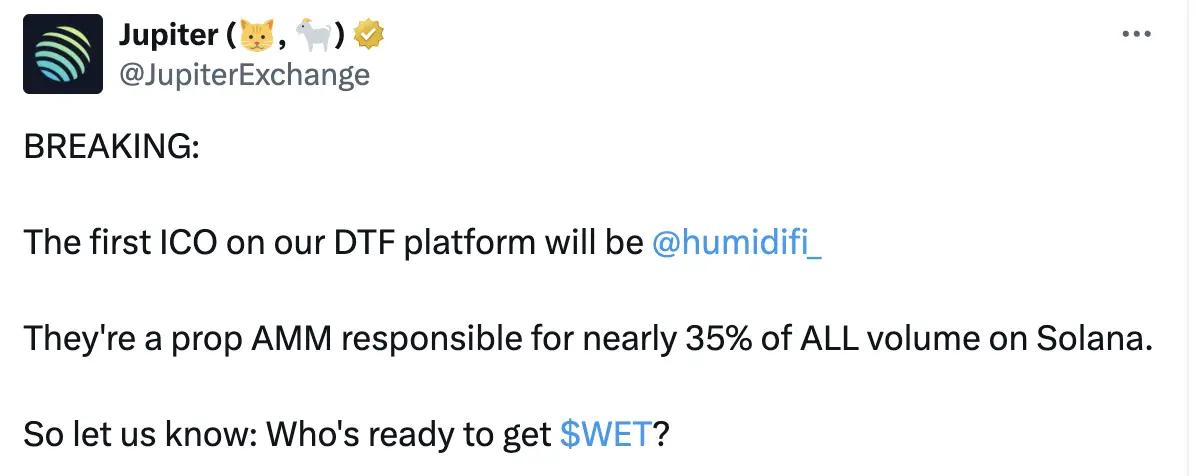
During a community call on the evening of October 30th, the Jupiter team announced the first launch project of their ICO platform DTF: HumidiFi, with the token token WET.
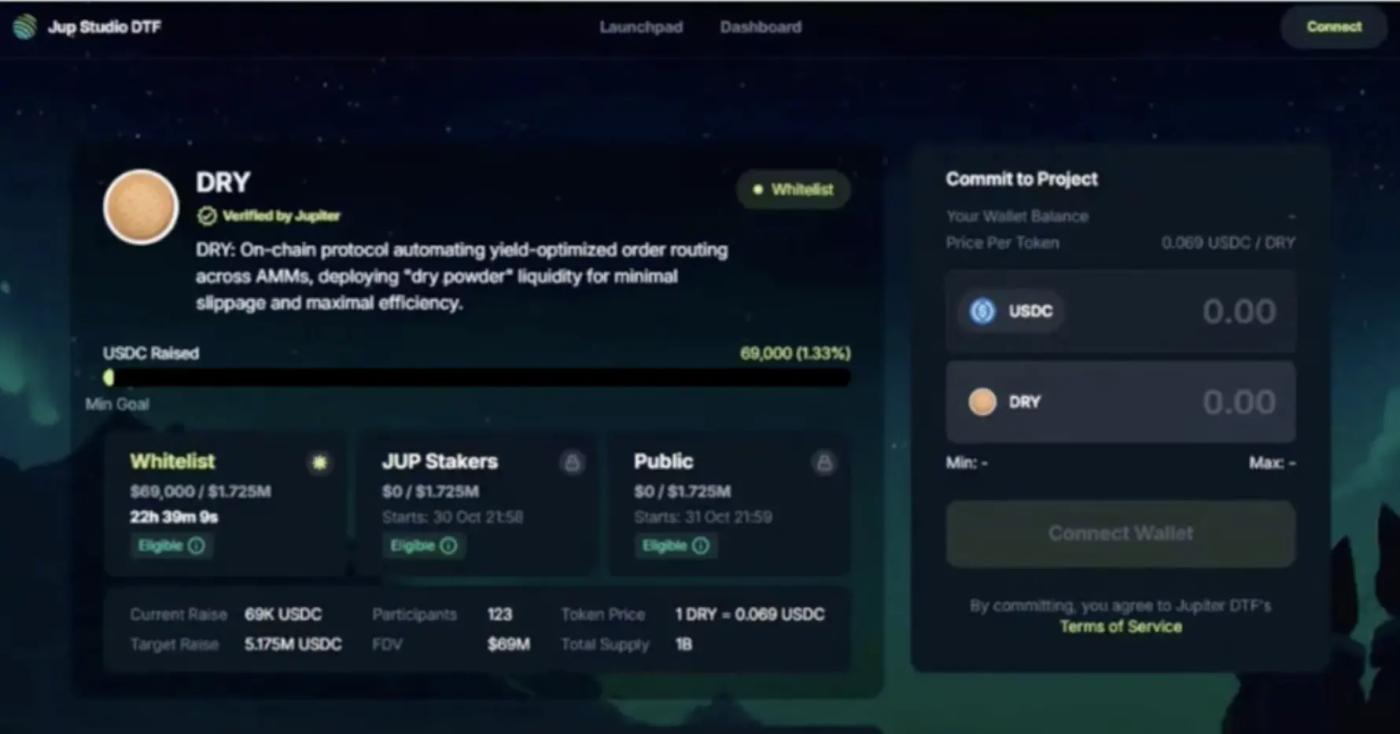
According to the disclosed sample webpage, the IPO subscription process is divided into three parts:
A whitelist (with acquisition rules yet to be determined) can secure a portion of the market share.
JUP pledgers can receive a guaranteed share based on the amount pledged.
The public share adopts a first-come, first-served (FCFS) model. Once the target amount is reached, it will immediately be available for trading on the blockchain, with no lock-up period.

It is worth noting that the HumidiFi team explicitly stated on Twitter that there was "no VC share," which is particularly rare in the current market environment filled with VC pre-sales and low liquidity with high FDV.
Proprietary AMMs are a "winner-takes-all" market. HumidiFi has achieved its current dominance through technological strength, but this also means that once a new competitor makes a breakthrough in CU efficiency or oracle speed, it could quickly erode HumidiFi's market share. This Proprietary AMM war has clearly only just begun.




